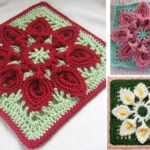At PatternCenter, we believe that mastering the magic ring is a game-changer for any crochet enthusiast. This technique, also known as a magic circle, is essential for starting projects like amigurumi, hats, and other circular designs. In this tutorial, we’ll walk you through the steps to create a magic ring, show a helpful video tutorial, share troubleshooting tips for beginners, and suggest projects where you can use the magic ring.
How to Make a Magic Ring in Crochet
Magic ring crochet video tutorial
Before we dive into our step-by-step guide, we highly recommend watching the magic ring crochet tutorial by YourCrochet.com. This video provides a clear and easy-to-follow demonstration of how to do a magic ring in crochet, making it perfect for visual learners. It’s a great complement to our written instructions and will help you see the technique in action.
Step-by-step guide to crochet magic ring
Form the loop
Start by holding the yarn tail in your left hand. Wrap the working yarn around your fingers to create a loop, ensuring the working yarn crosses over the tail end.
Insert the hook
Insert your crochet hook into the loop from front to back. Hook the working yarn and pull it through the loop.
Create the first chain
With the loop still on your hook, yarn over and pull through to make a chain. This chain secures the loop and serves as the first stitch of your magic ring.
Crochet inside the ring
Crochet the required number of stitches (usually single crochets) into the loop. Make sure to work over both the loop and the yarn tail.
Close the ring
Once you have the desired number of stitches, pull the yarn tail to tighten the loop and close the center hole.
Join the round
Depending on your pattern, you might need to join the round with a slip stitch into the first stitch.
Troubleshooting Tips for Beginners
Practice
The magic ring can be tricky initially. Practice with scrap yarn until you feel comfortable with the technique.
Use a larger hook
If you’re having difficulty, try using a larger hook. It can make it easier to see your stitches and handle the yarn.
Maintain loose tension
Keep a loose tension while forming the ring. Tight tension can make it hard to pull the yarn through.
Common Problems and How to Fix Them
The ring isn’t tightened
Ensure you’re working over both the loop and the yarn tail. This allows the tail to tighten the loop.
Too tight stitches
If your stitches are too tight, try loosening your grip on the yarn and hook to make inserting your hook and complete stitches easier.
Twisted ring
Make sure the yarn crosses over correctly when forming the initial loop. Practice forming the loop until it becomes second nature.
Crochet Projects Where to Use a Magic Ring
Amigurumi
The magic ring is ideal for starting amigurumi crochet projects. It creates a tightly closed center, preventing stuffing from showing through.
Crochet hats
Use the magic ring to begin making crochet hats and crochet beanies. This technique provides a neat, closed starting point.
Mandalas
Magic rings are perfect for starting mandala projects, offering a sturdy and closed center for your circular designs.
Crochet doilies
Begin a crochet doily with a magic ring for a professional finish. This method ensures a tight center, which is crucial for the intricate crochet patterns in doilies.
Crochet coasters
Using a magic ring, you can create beautiful and functional crochet coasters. This technique helps keep the center tightly closed, making your coasters durable and aesthetically pleasing.
FAQ
What exactly is a crochet magic ring?
A magic ring, or magic circle, is a technique for starting crocheting in the round. It lets you create an adjustable loop that can be pulled tight to eliminate any central hole, making it perfect for projects like amigurumi and hats.
How can I create a magic ring in crochet?
To make an easy magic ring crochet, wrap the yarn around your fingers to form a loop, insert your crochet hook into the loop, pull up a loop of yarn, and crochet the first round of stitches into the ring. Then, pull the yarn tail to close the ring tightly.
Why should I use a magic ring instead of starting with a chain loop?
The magic ring lets you start with a tightly closed center, avoiding the small hole that often appears with a chain loop start. This technique gives your work a more polished and professional look.
What kinds of projects benefit from using a magic ring?
This technique benefits projects like amigurumi, hats, coasters, and any items crocheted in the round by ensuring a tightly closed center.
How can I ensure my magic ring doesn’t come undone?
To keep your magic circle from unraveling, leave a long tail and weave it in securely. Some crocheters add extra security by dabbing fabric glue or clear nail polish on the knot.
What are some common issues with magic rings and how can I fix them?
Common problems include the ring not closing properly, stitches being too tight or too loose, and the ring unraveling. To avoid these issues, work over the yarn tail when making stitches, adjust your tension, and weave in the tail securely.
Check out the Common Problems section for more details. Learn how to crochet a magic ring perfectly!
Can different stitches be used with a magic ring?
Yes, you can use single crochet (sc), half double crochet (hdc), and double crochet (dc) with a magic ring. The number of chains you need to make before starting the stitches will differ depending on the stitch you are using.
Learning how to crochet in magic ring will enhance your skills and create beautiful, seamless starts for all your circular projects. Remember, practice is vital, and with time, you’ll become proficient in this essential technique. Happy crocheting from all of us at PatternCenter!



